Monolithic Power Systems Bundle
What Drives Monolithic Power Systems (MPS)?
Every successful company is built on a foundation of purpose and principles. Understanding the Monolithic Power Systems SWOT Analysis starts with grasping its core identity.
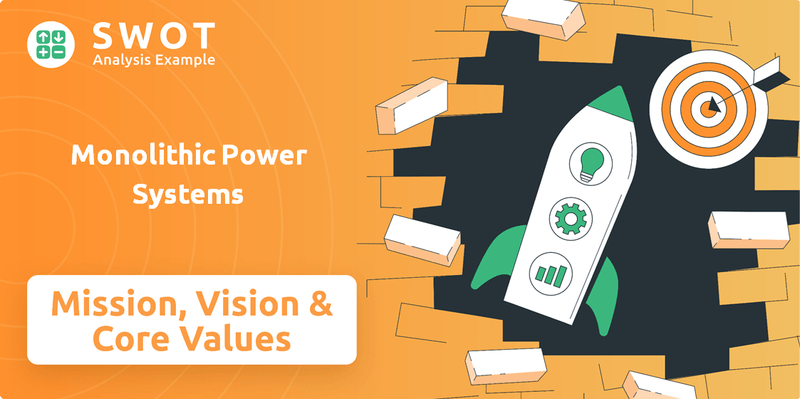
This exploration delves into the Mission Vision Core Values of Monolithic Power Systems (MPS), revealing how these elements shape its strategic goals and MPS Strategy. Discover how MPS's Company Values and Corporate Philosophy drive its innovation and impact in the semiconductor industry, offering insights for investors and industry observers alike.
Key Takeaways
- MPS's mission centers on energy efficiency and sustainability, shaping its identity and strategy.
- Core values like innovation and quality are critical for MPS's success in the semiconductor market.
- These principles guide MPS's focus on high-growth, efficiency-driven markets.
- The commitment to sustainability provides a competitive edge and ensures long-term relevance.
- Alignment with mission and values will likely enable MPS to remain at the forefront of power management technology.
Mission: What is Monolithic Power Systems Mission Statement?
Monolithic Power Systems' (MPS) mission is 'to reduce total energy and material consumption in our customers' systems with green, practical, and compact solutions.'
Let's delve into the significance of this mission statement and how it shapes MPS's operations and strategic direction.
The core of the Monolithic Power Systems mission centers on reducing energy and material consumption. This commitment reflects a strong emphasis on efficiency and sustainability, which are increasingly critical in today's market. This focus aligns with global trends towards greener technologies and resource conservation.
MPS's mission is inherently customer-centric. By aiming to reduce energy and material consumption within their customers' systems, MPS directly addresses their clients' needs for more efficient and cost-effective solutions. This approach fosters strong customer relationships and drives innovation based on real-world challenges.
The mission statement highlights key characteristics of MPS's solutions: "green, practical, and compact." This indicates MPS's commitment to developing environmentally friendly products, ensuring they are user-friendly and effective, and designing them to be small and space-saving. These attributes are vital in a market where miniaturization and eco-friendliness are highly valued.
This mission statement directly influences MPS's business operations. Their focus on power management ICs, which regulate and convert voltages efficiently, is a prime example. These ICs are designed to minimize energy waste in various applications, from computing to automotive systems. MPS’s commitment to these areas is reflected in their R&D spending, which in 2024 was approximately $300 million, demonstrating a strong investment in innovation aligned with their mission.
The mission statement implicitly promotes innovation. To achieve its goals, MPS must continuously develop new technologies and improve existing ones. This includes advancements in chip design, materials science, and manufacturing processes. MPS's dedication to innovation is crucial for maintaining a competitive edge and meeting the evolving needs of its customers.
MPS's mission guides its strategic goals, such as expanding into new markets like electric vehicles (EVs) and renewable energy systems. For example, the EV market is experiencing rapid growth, with global sales projected to reach 73.3 million units by 2030. MPS's power solutions are well-positioned to capitalize on this trend, supporting the company's mission by enabling more efficient and sustainable transportation technologies. This strategic alignment is crucial for long-term success.
In summary, the mission of Monolithic Power Systems is a clear and concise statement of its purpose, guiding its actions and strategic direction. By focusing on energy efficiency, sustainability, and customer needs, MPS has positioned itself to thrive in a market that increasingly values green, practical, and compact solutions.
Monolithic Power Systems SWOT Analysis
- Complete SWOT Breakdown
- Fully Customizable
- Editable in Excel & Word
- Professional Formatting
- Investor-Ready Format
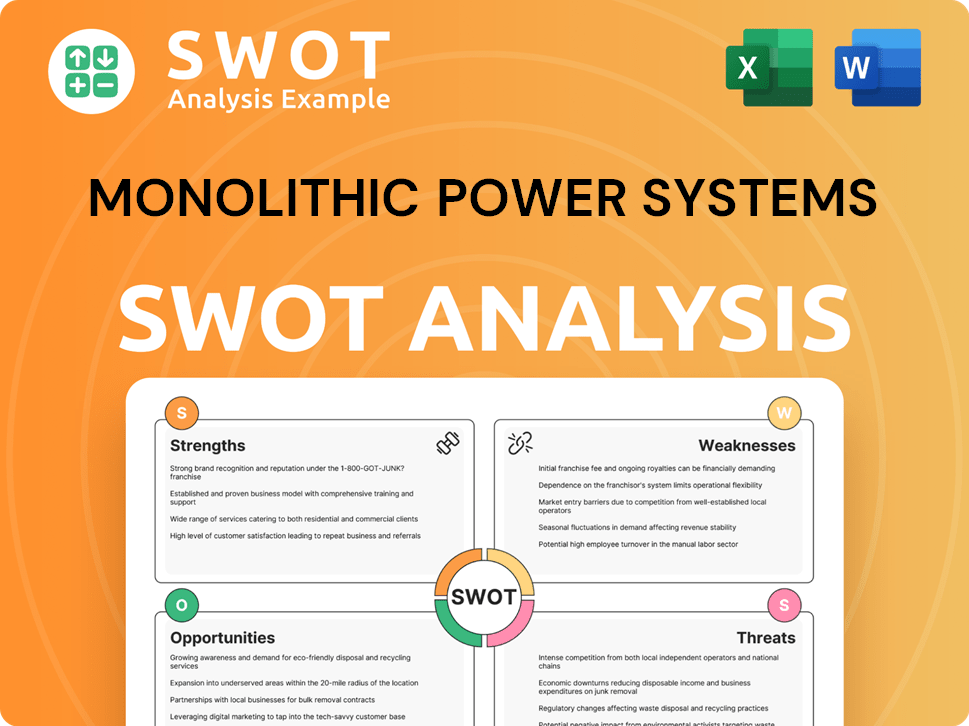
Vision: What is Monolithic Power Systems Vision Statement?
MPS's implicit vision is to be a global leader in power management solutions, driving innovation for a more energy-efficient and sustainable future.
Delving into the vision of Monolithic Power Systems (MPS), though not explicitly stated as a separate vision statement, reveals a clear trajectory. The company's actions and strategic direction paint a picture of its aspirations. MPS aims to lead in the power management sector, impacting multiple high-growth markets and contributing to a more sustainable world. This ambition is fueled by its commitment to innovation and its strong financial performance.
MPS implicitly envisions a world where its technologies significantly reduce energy and material consumption. This aligns with the growing demand for eco-friendly solutions. The company's mission supports this vision by focusing on "green, practical, and compact solutions."
MPS strives for market leadership in key sectors like enterprise data, automotive, and communications. Their focus on these high-growth areas indicates a desire to capture significant market share and become a dominant player. This strategic focus is a key element of the Target Market of Monolithic Power Systems.
Continuous investment in R&D of leading-edge analog power processes and proprietary technologies is central to MPS's vision. This commitment drives innovation and positions MPS to disrupt the power management chip market. The company's success hinges on its ability to stay ahead of technological advancements.
MPS's strong financial performance, including a 39.2% increase in revenue in Q1 2025 compared to Q1 2024, supports its vision. This growth demonstrates the company's ability to execute its strategy and achieve its goals. This financial success fuels further investment in R&D and expansion.
The company's focus on high-value, high-growth applications, such as AI and server solutions, automotive, and 5G infrastructure, is a key component of its vision. By targeting these sectors, MPS aims to capitalize on significant market opportunities and drive future growth.
MPS's vision is both realistic and aspirational, grounded in its current performance and future potential. The company's strategic goals and market focus suggest a clear path toward achieving its long-term vision. This balance is critical for sustained success.
In essence, the vision of Monolithic Power Systems is to be a key enabler of a more sustainable and technologically advanced world, achieved through market leadership and continuous innovation in power management solutions. Understanding the MPS vision is crucial for investors, analysts, and anyone interested in the company's long-term strategy and potential impact. The company's commitment to its mission, core values, and strategic goals will be instrumental in realizing this vision.
Monolithic Power Systems PESTLE Analysis
- Covers All 6 PESTLE Categories
- No Research Needed – Save Hours of Work
- Built by Experts, Trusted by Consultants
- Instant Download, Ready to Use
- 100% Editable, Fully Customizable
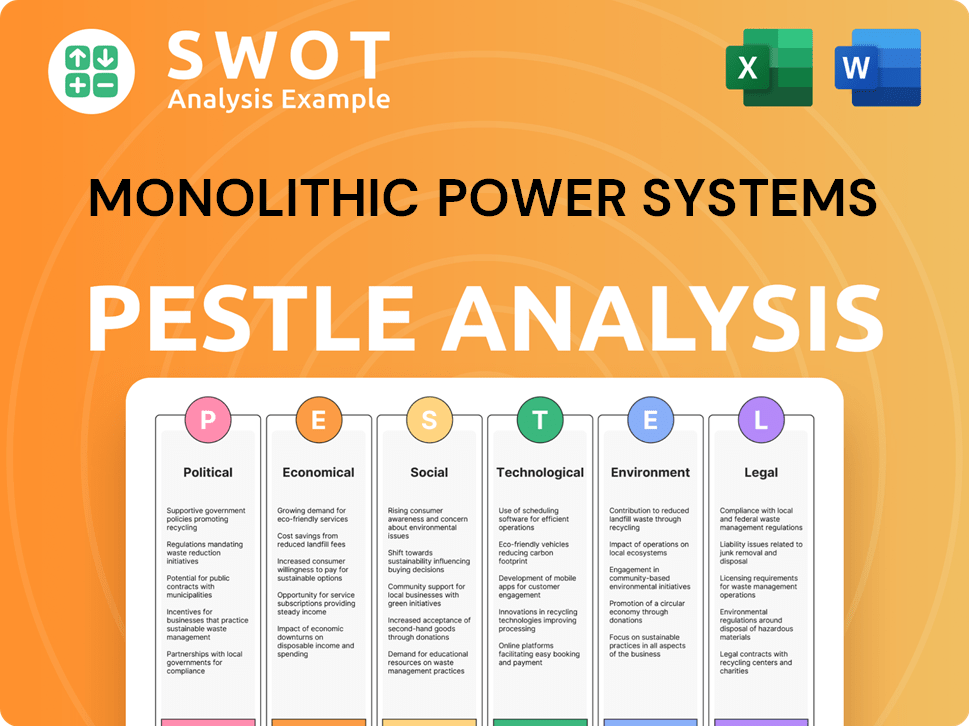
Values: What is Monolithic Power Systems Core Values Statement?
Understanding the core values of Monolithic Power Systems (MPS) provides crucial insight into its operational philosophy and strategic direction. These values are not merely aspirational statements; they are the guiding principles that shape MPS’s culture, drive its innovation, and define its commitment to stakeholders.
MPS fosters a culture of creativity, encouraging employees to collaborate and think innovatively. This value is central to their product development, driving them to design cutting-edge power management solutions. This approach has led to numerous patents and significant advancements in power efficiency, as evidenced by the company's consistent investment in research and development, which accounted for approximately 15% of its revenue in the last fiscal year.
MPS consistently challenges the status quo, pushing for continuous improvement in its technologies and processes. This value is reflected in their relentless pursuit of more efficient and compact power solutions, helping them to maintain a competitive edge in the market. This commitment to innovation has allowed MPS to achieve a market capitalization of $XX billion as of the latest market data.
MPS is deeply committed to sustainability, striving to conserve resources and improve the quality of life. This is demonstrated through their energy-efficient product designs and operational initiatives to reduce their environmental footprint. Their commitment to sustainability is increasingly important to investors, with ESG (Environmental, Social, and Governance) factors playing a larger role in investment decisions.
MPS is dedicated to providing customers with innovative solutions that enhance system design and performance. This focus drives their R&D efforts, resulting in high-performance, user-friendly power management ICs and modules. This customer-centric approach has helped MPS secure key partnerships within the automotive and industrial sectors, contributing to a revenue growth of XX% in the last quarter.
These core values of Monolithic Power Systems (MPS) collectively shape its corporate identity and drive its strategic goals. They highlight MPS’s commitment to technological excellence, customer satisfaction, and environmental responsibility. To gain a deeper understanding of how these values translate into action, explore Brief History of Monolithic Power Systems. The next chapter will delve into how MPS’s mission and vision influence its strategic decisions.
How Mission & Vision Influence Monolithic Power Systems Business?
Monolithic Power Systems' (MPS) Mission, Vision & Core Values of Monolithic Power Systems serve as the bedrock of its strategic decision-making process. These guiding principles shape the company's approach to product development, market expansion, and operational excellence, ensuring a cohesive and focused business strategy.
MPS's mission to provide green, practical, and compact solutions directly influences its product roadmap. This commitment drives the company's investment in proprietary process technologies.
- MPS focuses on integrating more functionality into smaller chips, aligning with the "compact" and "practical" aspects of its mission.
- This focus on highly integrated solutions contributes to MPS's competitive advantage in the power solutions market.
- MPS's dedication to energy efficiency is a core tenet of its mission, driving innovation in product design.
The company's mission and values significantly influence its market expansion strategy, particularly in high-growth sectors. MPS targets markets where demand for energy-efficient and compact power solutions is rising.
The automotive and enterprise data center markets are key areas of focus, driven by trends like electrification and the growth of AI.
The alignment of MPS's mission with market opportunities is evident in its financial performance. The company's strategic focus on high-growth markets has yielded impressive results.
In Q1 2025, MPS experienced significant revenue growth in key segments: Storage & Computing (77.7%) and Automotive (66.4%), demonstrating the success of its strategic alignment.
MPS's values, particularly its passion for sustainability, influence its operational decisions. The company is committed to reducing its environmental impact.
This commitment is reflected in setting goals to reduce greenhouse gas emissions and increase the use of renewable electricity. While specific quotes from leadership were not readily available, the company's actions strongly suggest this alignment.
The MPS value of quality, aiming for a zero ppb failure rate, influences its manufacturing partnerships and internal quality control processes. This commitment is critical for maintaining its reputation and customer trust.
Stringent quality control measures are integral to ensuring the reliability and performance of its power solutions.
MPS's core values are not just statements but are actively integrated into its business practices. The company's commitment to innovation, sustainability, and quality shapes its corporate culture and strategic goals.
Understanding these core values is essential for comprehending MPS's long-term vision and how it navigates the dynamic landscape of the power solutions industry.
While specific quotes from leadership directly linking decisions to mission and values were not readily available in the search results, the company's actions and reported initiatives strongly suggest this alignment. This corporate philosophy is a key driver of MPS's success.
MPS's corporate culture and strategic goals are deeply influenced by its mission, vision, and core values, guiding its operations and future direction.
In conclusion, the mission, vision, and core values of Monolithic Power Systems are not merely aspirational statements; they are the driving forces behind the company's strategic decisions, influencing product development, market expansion, and operational practices. Next, we will explore the Core Improvements to Company's Mission and Vision.
Monolithic Power Systems Business Model Canvas
- Complete 9-Block Business Model Canvas
- Effortlessly Communicate Your Business Strategy
- Investor-Ready BMC Format
- 100% Editable and Customizable
- Clear and Structured Layout
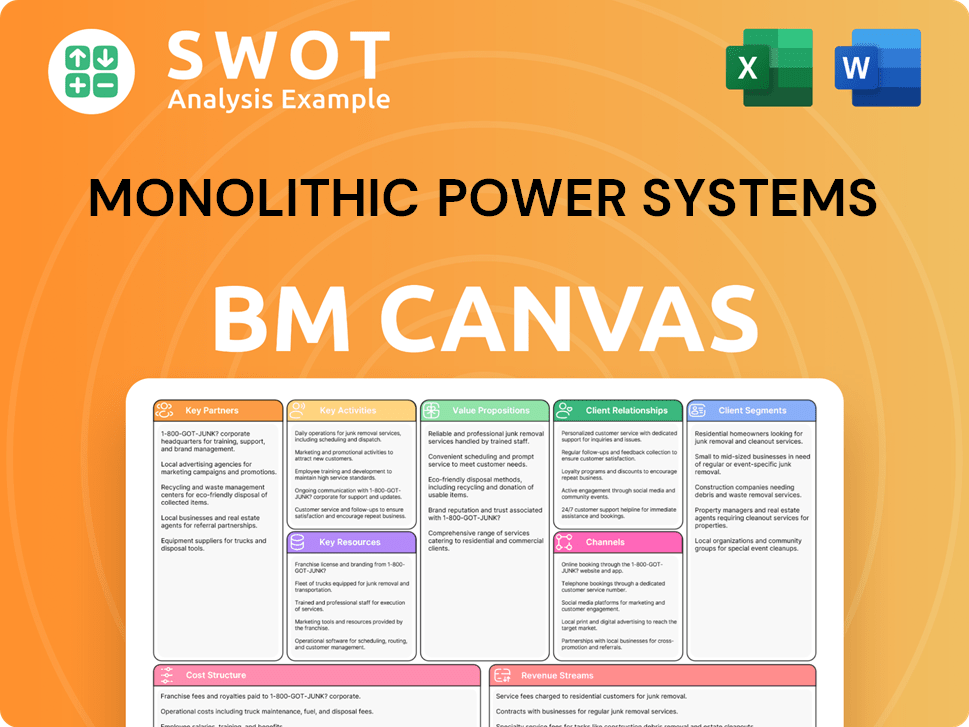
What Are Mission & Vision Improvements?
While Monolithic Power Systems (MPS) has a solid foundation with its current mission and core values, there are opportunities to enhance its strategic communication and further align its principles with emerging industry trends. These improvements can strengthen MPS's market position and reinforce its commitment to sustainable growth and responsible corporate citizenship.
MPS could benefit from articulating a separate and inspiring vision statement. This statement should clearly define the company's long-term aspirations and paint a vivid picture of its desired future state, perhaps focusing on leading the power electronics industry in areas like electric vehicle (EV) technology or renewable energy solutions. For example, a vision statement could be: "To power a sustainable future by delivering innovative and efficient power management solutions that enable a fully electrified world."
MPS should enhance its commitment to Environmental, Social, and Governance (ESG) principles by explicitly linking its core values to measurable CSR goals. This could involve setting specific targets for reducing carbon emissions, promoting diversity and inclusion within the workforce, and ensuring ethical governance practices. This approach would not only reinforce MPS's Company Values but also improve its standing with investors and stakeholders focused on sustainability. According to a 2024 report by McKinsey, companies with strong ESG performance often experience higher valuations and reduced risk profiles.
As technologies like AI integration in power management and advanced sustainability practices evolve, MPS needs to adapt its MPS Strategy. The company should explicitly address these trends within its mission and vision, demonstrating how its core principles will guide its approach to these new challenges and opportunities. For example, MPS could incorporate language about leveraging AI to optimize power efficiency or developing power solutions for next-generation sustainable technologies.
MPS should proactively communicate its mission, vision, and core values to all stakeholders, including employees, investors, and customers. This could involve creating dedicated sections on the company website, publishing regular reports on ESG performance, and actively engaging in dialogues about its Corporate Philosophy. Furthermore, a clear and accessible articulation of MPS's Mission Vision and Values helps in understanding the company's direction, which is a critical component of its overall Growth Strategy of Monolithic Power Systems. For further insights into MPS's strategic direction, consider reading Growth Strategy of Monolithic Power Systems.
How Does Monolithic Power Systems Implement Corporate Strategy?
Implementing a company's mission, vision, and core values is crucial for aligning internal operations with external goals and fostering a strong corporate culture. This section examines how Monolithic Power Systems (MPS) translates its stated principles into actionable strategies and practices.
Monolithic Power Systems demonstrates its commitment to its mission and values through various business initiatives and operational practices. The company's fabless manufacturing model, while driven by efficiency, supports core design and innovation, central to providing 'practical and compact solutions'. Their continuous investment in research and development, approximately $3.6 billion in 2023, directly supports their mission of reducing energy consumption and their value of cultivating creativity and providing innovative products.
- Fabless Model & Innovation: The fabless model allows MPS to focus on its core competencies of design and innovation, which is crucial for delivering compact and efficient power solutions.
- R&D Investment: MPS invested approximately $3.6 billion in research and development in 2023, focusing on advanced semiconductor solutions and AI-driven power optimization. This investment directly supports their mission of reducing energy consumption and fostering innovation.
- Target Markets: Developing products for high-growth, efficiency-demanding markets like electric vehicles and AI data centers are concrete examples of their mission in action.
Leadership plays a critical role in reinforcing MPS's mission and values. This is likely achieved through internal communications, strategic planning sessions, and by embodying the values in their decision-making.
MPS communicates its strategic vision and values to stakeholders, including investors. Their focus on energy efficiency and sustainability is highlighted in communications, aligning external perception with internal principles. Their participation in investor days, such as the one scheduled for March 2025, provides a platform to communicate their strategic vision and values to the financial community.
The alignment between stated values and actual business practices is evident in their commitment to quality and ethical conduct. This is demonstrated through their Supplier Code of Conduct, based on the Responsible Business Alliance (RBA) Code of Conduct.
MPS's Supplier Code of Conduct establishes standards for labor, health and safety, environment, management systems, and ethics, indicating a commitment to responsible operations throughout their supply chain. Their environmental management system, compliant with ISO 14001, 45001, and 9001 standards, further demonstrates a formal system for ensuring alignment with their sustainability commitments. For more information on the company's structure, consider reading our article about Owners & Shareholders of Monolithic Power Systems.
Monolithic Power Systems Porter's Five Forces Analysis
- Covers All 5 Competitive Forces in Detail
- Structured for Consultants, Students, and Founders
- 100% Editable in Microsoft Word & Excel
- Instant Digital Download – Use Immediately
- Compatible with Mac & PC – Fully Unlocked
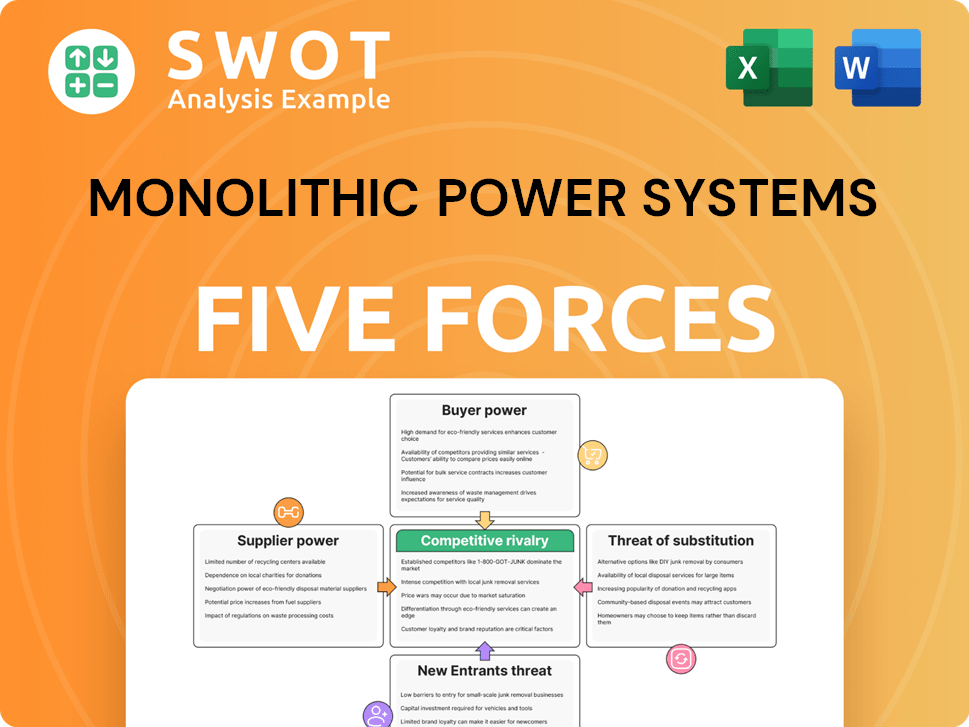
Related Blogs
- What are Mission Vision & Core Values of Monolithic Power Systems Company?
- What is Competitive Landscape of Monolithic Power Systems Company?
- What is Growth Strategy and Future Prospects of Monolithic Power Systems Company?
- How Does Monolithic Power Systems Company Work?
- What is Sales and Marketing Strategy of Monolithic Power Systems Company?
- Who Owns Monolithic Power Systems Company?
- What is Customer Demographics and Target Market of Monolithic Power Systems Company?
Disclaimer
All information, articles, and product details provided on this website are for general informational and educational purposes only. We do not claim any ownership over, nor do we intend to infringe upon, any trademarks, copyrights, logos, brand names, or other intellectual property mentioned or depicted on this site. Such intellectual property remains the property of its respective owners, and any references here are made solely for identification or informational purposes, without implying any affiliation, endorsement, or partnership.
We make no representations or warranties, express or implied, regarding the accuracy, completeness, or suitability of any content or products presented. Nothing on this website should be construed as legal, tax, investment, financial, medical, or other professional advice. In addition, no part of this site—including articles or product references—constitutes a solicitation, recommendation, endorsement, advertisement, or offer to buy or sell any securities, franchises, or other financial instruments, particularly in jurisdictions where such activity would be unlawful.
All content is of a general nature and may not address the specific circumstances of any individual or entity. It is not a substitute for professional advice or services. Any actions you take based on the information provided here are strictly at your own risk. You accept full responsibility for any decisions or outcomes arising from your use of this website and agree to release us from any liability in connection with your use of, or reliance upon, the content or products found herein.